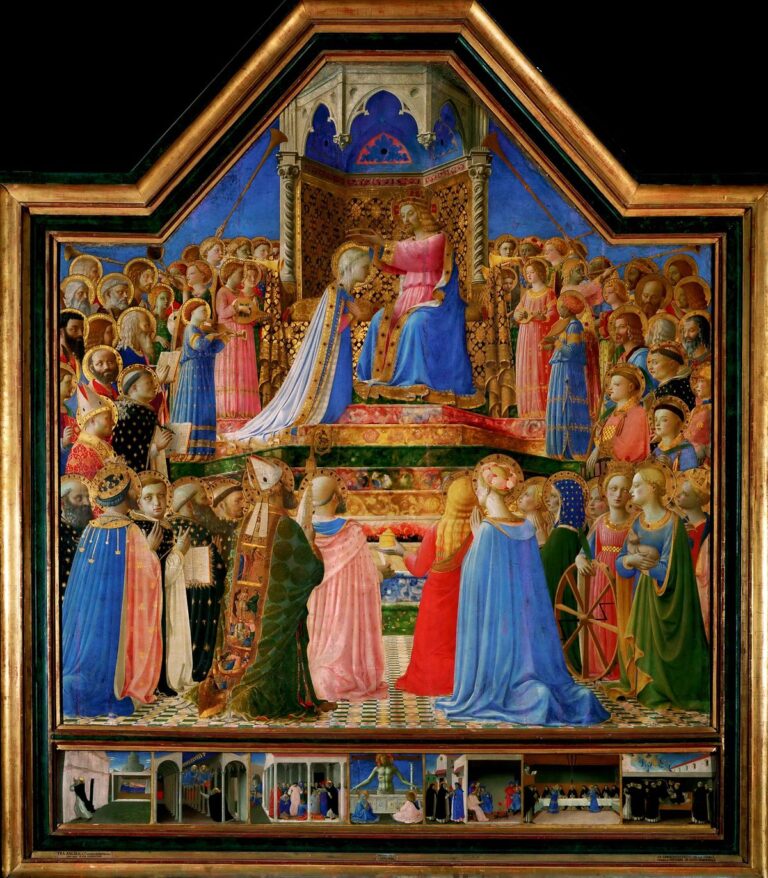26th May 2021
Mary, Queen of Heaven
Adam Coates
In our previous post in this series, we considered Our Lady’s Assumption as that moment when Mary was taken up into Heaven, body and soul, to be united with her Son. In this post we will examine what it means for Mary to reign as Queen of Heaven, at her Son’s side.
To examine what this title of Queen means, it is necessary to turn to the Old Testament. When one typically thinks of a Queen, they often imagine the wife of a King. It is not so in the Old Testament. In the first Book of Kings, Bathsheba, the mother of King Solomon, is seated at her son’s right hand and Solomon states that requests to him should be directed through his mother, so that she might intercede for them before him (1 Kings 2:19-20). Moving to the Psalms, we are told that the Queen shall stand at the right side of the King (Psalm 45:9). In the final verse of this Psalm, this Queen is addressed directly and told that she will be “celebrated in all generations” and that “therefore the peoples will praise you for ever and ever”.
Anyone familiar with the New Testament should be instantly reminded of Our Lady’s Magnificat in St. Luke’s Gospel. Here Mary says that, due to God’s blessings, “henceforth all generations will call me blessed” (Luke 1:48). This Queenship of Mary has been put into effect from the moment of her ‘yes’ to the Angel Gabriel: by opening the door to salvation, the subject of our first post, she puts herself on this path. In the Magnificat we are further told that God has seen Mary’s humble state, and that He will exalt the lowly in place of the mighty who have been cast down from their thrones (Luke 1:48, 52). It is obvious what is being said here: Mary is the humblest of God’s creatures, for she is the perfect disciple, and, thus, she is destined for Queenship; Mary is destined for glory. Christ, in ascending into his glory with his Resurrection and Ascension into heaven, gives a similar tribute to Mary. He assumes her into heaven and crowns her as Queen.
The Second Vatican Council’s Lumen Gentium expresses this by saying that Mary was “exalted by the Lord as Queen of the universe, that she might be the more fully conformed to her Son, the Lord of lords”. Truly, Our Lady’s coronation as Queen is the culmination and the continuation of her mission as the Lord Jesus’ perfect disciple. In St. John Paul II’s words, “She who at the Annunciation called herself the “handmaid of the Lord” remained throughout her earthly life faithful to what this name expresses. In this she confirmed that she was a true “disciple” of Christ, who strongly emphasised that his mission was one of service … she fully obtained that “state of royal freedom” proper to Christ’s disciples: to serve means to reign”! Her service of faithful discipleship makes possible her reign as Queen.
Generations, indeed, have called Mary blessed and glorified her name. As St. John Henry Newman explains, these glories of Mary are fitting to her state. But they are given not for her glory or her exaltation, but, rather, for the sake of her Son, and also for our sake so as to provide us with an example to follow. In St. John Henry’s own words: “Let us copy her faith, who received God’s message by the angel without a doubt; her patience, who endured St. Joseph’s surprise without a word; her obedience, who went up to Bethlehem in the winter and bore our Lord in a stable; her meditative spirit, who pondered in her heart what she saw and heard about Him; her fortitude, whose heart the sword went through; her self-surrender, who gave Him up during His ministry and consented to His death”. Mary has consistently been an example and model for Christians to follow and, in glorifying her as the Church does, her perfect discipleship is made clearer for the Church to imitate.
We should also be clear that devotion to Mary as Queen in no way diminishes the devotion proper to her Son. The great Archbishop Sheen reminds us that “devotion to the Mother of our Lord in no way detracts from the adoration of her divine son. The brightness of the moon does not detract from the brilliance of the sun but rather bespeaks its brilliance”. All glories given to Mary are not, in the end, to glorify her, but to glorify Him who gave her all these good things.
Thus, whilst all things are given to Christ the King, they can be given through Mary the Queen. Numerous works of art, hymns, and poetry have been written to the Virgin Mary for the glory of Jesus Christ. One such poem is St. John Henry Newman’s The Queen of Seasons. This is a wonderful meditation on Mary’s Queenship and a beautiful act of devotion. It is devotion to Our Lady which we will discuss in the next, and final, post of this series.
Further reading
- St. John Henry Newman, Discourse 18. On the Fitness of the Glories of Mary
- St. John Henry Newman, The Queen of Seasons (A Song for an Inclement May)
- Pope Pius XII, Ad Caeli Reginam
- Archbishop Fulton Sheen, Three to Get Married, Chapter 17: Mary, Motherhood, and the Home.
- Lumen Gentium, 59
- St. John Paul II, Redemptoris Mater, 41
- Catechism of the Catholic Church, 966

